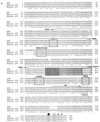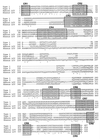Sequence and functional analysis of EBNA-LP and EBNA2 proteins from nonhuman primate lymphocryptoviruses
- PMID: 10590127
- PMCID: PMC111549
- DOI: 10.1128/jvi.74.1.379-389.2000
Sequence and functional analysis of EBNA-LP and EBNA2 proteins from nonhuman primate lymphocryptoviruses
Abstract
The Epstein-Barr virus (EBV) EBNA-LP and EBNA2 proteins are the first to be synthesized during establishment of latent infection in B lymphocytes. EBNA2 is a key transcriptional regulator of both viral and cellular gene expression and is essential for EBV-induced immortalization of B lymphocytes. EBNA-LP is also important for EBV-induced immortalization of B lymphocytes, but far less is known about the functional domains and cellular cofactors that mediate EBNA-LP function. While recent studies suggest that serine phosphorylation of EBNA-LP and coactivation of EBNA2-mediated transactivation are important, more detailed mutational and genetic studies are complicated by the repeat regions that comprise the majority of the EBNA-LP sequence. Therefore, we have used a comparative approach by studying the EBNA-LP homologues from baboon and rhesus macaque lymphocryptoviruses (LCVs) (baboon LCV and rhesus LCV). The predicted baboon and rhesus LCV EBNA-LP amino acid sequences are 61 and 64% identical to the EBV EBNA-LP W1 and W2 exons and 51% identical to the EBV EBNA-LP Y1 and Y2 exons. Five evolutionarily conserved regions can be defined, and four of eight potential serine residues are conserved among all three EBNA-LPs. The major internal repeat sequence also revealed a highly conserved Wp EBNA promoter with strong conservation of upstream activating sequences important for Wp transcriptional regulation. To test whether transcriptional coactivating properties were common to the rhesus LCV EBNA-LP, a rhesus LCV EBNA2 homologue was cloned and expressed. The rhesus LCV EBNA2 transcriptionally transactivates EBNA2-responsive promoters through a CBF1-dependent mechanism. The rhesus LCV EBNA-LP was able to further enhance rhesus LCV or EBV EBNA2 transactivation 5- to 12-fold. Thus, there is strong structural and functional conservation among the simian EBNA-LP homologues. Identification of evolutionarily conserved serine residues and regions in EBNA-LP homologues provides important clues for identifying the cellular cofactors and molecular mechanisms mediating these conserved viral functions.
Figures









Similar articles
-
Structural, functional, and genetic comparisons of Epstein-Barr virus nuclear antigen 3A, 3B, and 3C homologues encoded by the rhesus lymphocryptovirus.J Virol. 2000 Jul;74(13):5921-32. doi: 10.1128/jvi.74.13.5921-5932.2000. J Virol. 2000. PMID: 10846073 Free PMC article.
-
Transcriptional regulatory properties of Epstein-Barr virus nuclear antigen 3C are conserved in simian lymphocryptoviruses.J Virol. 2003 May;77(10):5639-48. doi: 10.1128/jvi.77.10.5639-5648.2003. J Virol. 2003. PMID: 12719556 Free PMC article.
-
Complete genomic sequence of an Epstein-Barr virus-related herpesvirus naturally infecting a new world primate: a defining point in the evolution of oncogenic lymphocryptoviruses.J Virol. 2002 Dec;76(23):12055-68. doi: 10.1128/jvi.76.23.12055-12068.2002. J Virol. 2002. PMID: 12414947 Free PMC article.
-
EBNA2 and Its Coactivator EBNA-LP.Curr Top Microbiol Immunol. 2015;391:35-59. doi: 10.1007/978-3-319-22834-1_2. Curr Top Microbiol Immunol. 2015. PMID: 26428371 Review.
-
Non-human Primate Lymphocryptoviruses: Past, Present, and Future.Curr Top Microbiol Immunol. 2015;391:385-405. doi: 10.1007/978-3-319-22834-1_13. Curr Top Microbiol Immunol. 2015. PMID: 26428382 Review.
Cited by
-
Structural, functional, and genetic comparisons of Epstein-Barr virus nuclear antigen 3A, 3B, and 3C homologues encoded by the rhesus lymphocryptovirus.J Virol. 2000 Jul;74(13):5921-32. doi: 10.1128/jvi.74.13.5921-5932.2000. J Virol. 2000. PMID: 10846073 Free PMC article.
-
Epstein-Barr virus protein EBNA-LP engages YY1 through leucine-rich motifs to promote naïve B cell transformation.PLoS Pathog. 2024 Jul 31;20(7):e1011950. doi: 10.1371/journal.ppat.1011950. eCollection 2024 Jul. PLoS Pathog. 2024. PMID: 39083560 Free PMC article.
-
Conserved regions in the Epstein-Barr virus leader protein define distinct domains required for nuclear localization and transcriptional cooperation with EBNA2.J Virol. 2000 Nov;74(21):9953-63. doi: 10.1128/jvi.74.21.9953-9963.2000. J Virol. 2000. PMID: 11024123 Free PMC article.
-
Tumor viruses and cancer biology: Modulating signaling pathways for therapeutic intervention.Cancer Biol Ther. 2010 Nov 15;10(10):961-78. doi: 10.4161/cbt.10.10.13923. Epub 2010 Nov 15. Cancer Biol Ther. 2010. PMID: 21084867 Free PMC article. Review.
-
Amino acids of Epstein-Barr virus nuclear antigen 3A essential for repression of Jkappa-mediated transcription and their evolutionary conservation.J Virol. 2001 Jan;75(1):90-9. doi: 10.1128/JVI.75.1.90-99.2001. J Virol. 2001. PMID: 11119577 Free PMC article.
References
-
- Alfieri C, Birkenbach M, Kieff E. Early events in Epstein-Barr virus infection of human B lymphocytes. Virology. 1991;181:595–608. . (Erratum, 185:946.) - PubMed
-
- Bell A, Skinner J, Kirby H, Rickinson A. Characterisation of regulatory sequences at the Epstein-Barr virus BamHI W promoter. Virology. 1998;252:149–161. - PubMed
Publication types
MeSH terms
Substances
Grants and funding
LinkOut - more resources
Full Text Sources
Other Literature Sources
Research Materials

